Food Ingredients
Listed are the food ingredients specified on the AC syllabus. These are extracts from Wikipedia, with links to the Wikipedia page.

Arugula
Read More...Rocket, eruca, or arugula (Eruca vesicaria; syns. Eruca sativa Mill., E. vesicaria subsp. sativa (Miller) Thell., Brassica eruca L.) is an edible annual plant in the family Brassicaceae used as a leaf vegetable for its fresh, tart, bitter, and peppery flavor. Its other common names include "garden rocket" (in Britain, Australia, South Africa, Ireland, and New Zealand), as well as "colewort", "roquette", "ruchetta", "rucola", "rucoli", and "rugula". E. vesicaria is widely popular as a salad vegetable and it is a species of Eruca native to the Mediterranean region.
Arugula is sometimes conflated with Diplotaxis tenuifolia, known as "perennial wall rocket", another plant of the family Brassicaceae that is used in the same manner.

Basmati
Read More...Basmati, pronounced ['bɑːsmət̪iː], is a variety of long, slender-grained aromatic rice which is traditionally grown in the Indian subcontinent, mainly India, Pakistan, Sri Lanka and Nepal. As of 2019, India accounted for 65% of the international trade in basmati rice, while Pakistan accounted for the remaining 35%. Many countries use domestically grown basmati rice crops; however, basmati is geographically exclusive to certain districts of India and Pakistan.
According to the Indian Agricultural and Processed Food Products Export Development Authority (APEDA), a rice variety is eligible to be called basmati if it has a minimum average precooked milled rice length of 6.61 mm (0.260 in) and average precooked milled rice breadth of up to 2 mm (0.079 in), among other parameters.

Bok choy
Read More...Bok choy (American English, Canadian English, and Australian English), pak choi (British English) or pok choi (Brassica rapa subsp. chinensis) is a type of Chinese cabbage, used as food. Chinensis varieties do not form heads and have green leaf blades with lighter bulbous bottoms instead, forming a cluster reminiscent of mustard greens. It has a flavor between spinach and water chestnuts but is slightly sweeter, with a mildly peppery undertone. The green leaves have a stronger flavor than the white bulb.
Chinensis varieties are popular in southern China, East Asia, and Southeast Asia. Being winter-hardy, they are increasingly grown in Northern Europe. Now considered a subspecies of Brassica rapa, this group was originally classified as its own species under the name Brassica chinensis by Carl Linnaeus. They are a member of the family of Brassicaceae or Cruciferae, also commonly known as the mustards, the crucifers, or the cabbage family.

Bulgur
Read More...Bulgur (Turkish: bulgur; Armenian: բլղուր, romanized: blghur; Persian: بلغور, romanized: bolġur/balġur, lit. 'groats'), or burghul (Arabic: برغل, romanized: burġul), is a cracked wheat foodstuff found in West Asian cuisine.
Bulgur is sometimes confused with cracked wheat, which is crushed wheat grain that, unlike bulgur, has not been parboiled. Bulgur is a common ingredient in cuisines of many countries of the West Asian cuisine and Mediterranean Basin. It has a light, nutty flavor.
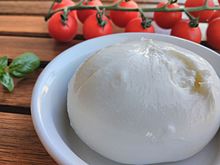
Burrata
Read More...Burrata (Italian: [burˈrata]) is an Italian cow's milk (occasionally buffalo milk) cheese made from mozzarella and cream. The outer casing is solid cheese, while the inside contains stracciatella and clotted cream, giving it an unusual, soft texture. It is typical of Apulia.

Camembert
Read More...Camembert (, also UK: , French: [kamɑ̃bɛʁ] ) is a moist, soft, creamy, surface-ripened cow's milk cheese. It was first made in the late 18th century in Camembert, Normandy, in northwest France. It is sometimes compared in look and taste to brie cheese, albeit with a slightly lower butterfat content than brie's typically 20% - 25% by weight.

Capers
Read More...Capparis spinosa, the caper bush, also called Flinders rose, is a perennial plant that bears rounded, fleshy leaves and large white to pinkish-white flowers.
The plant is best known for the edible flower buds (capers), used as a seasoning or garnish, and the fruit (caper berries), both of which are usually consumed salted or pickled. Other species of Capparis are also picked along with C. spinosa for their buds or fruits. Other parts of Capparis plants are used in the manufacture of medicines and cosmetics.
Capparis spinosa is native to almost all the circum-Mediterranean countries, and is included in the flora of most of them, but whether it is indigenous to this region is uncertain. The family Capparaceae could have originated in the tropics and later spread to the Mediterranean basin.
The taxonomic status of the species is controversial and unsettled. Species within the genus Capparis are highly variable, and interspecific hybrids have been common throughout the evolutionary history of the genus. As a result, some authors have considered C. spinosa to be composed of multiple distinct species, others that the taxon is a single species with multiple varieties or subspecies, or that the taxon C. spinosa is a hybrid between C. orientalis and C. sicula.

Caraway
Read More...Caraway, also known as meridian fennel and Persian cumin (Carum carvi), is a biennial plant in the family Apiaceae, native to western Asia, Europe, and North Africa.
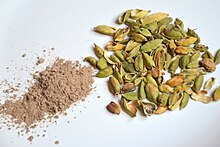
Cardamom
Read More...Cardamom (), sometimes cardamon or cardamum, is a spice made from the seeds of several plants in the genera Elettaria and Amomum in the family Zingiberaceae. Both genera are native to the Indian subcontinent and Indonesia. They are recognized by their small seed pods: triangular in cross-section and spindle-shaped, with a thin, papery outer shell and small, black seeds; Elettaria pods are light green and smaller, while Amomum pods are larger and dark brown.
Species used for cardamom are native throughout tropical and subtropical Asia. The first references to cardamom are found in Sumer, and in the Ayurvedic literature of India. Nowadays it is also cultivated in Guatemala, Malaysia, and Tanzania. The German coffee planter Oscar Majus Klöffer introduced Indian cardamom to cultivation in Guatemala before World War I; by 2000, that country had become the biggest producer and exporter of cardamom in the world, followed by India.
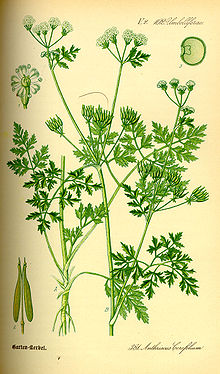
Chervil
Read More...Chervil (; Anthriscus cerefolium), sometimes called French parsley or garden chervil (to distinguish it from similar plants also called chervil), is a delicate annual herb related to parsley. It was formerly called myrhis due to its volatile oil with an aroma similar to the resinous substance myrrh. It is commonly used to season mild-flavoured dishes and is a constituent of the French herb mixture fines herbes.
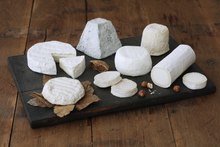
Chevre
Read More...Goat cheese, goat's cheese or chèvre ( or ; from the French fromage de chèvre, lit. 'goat cheese') is cheese made from goat's milk. Goats were among the first animals to be domesticated for producing food. Goat cheese is made around the world with a variety of recipes, giving many different styles of cheeses, from fresh and soft to aged and hard.
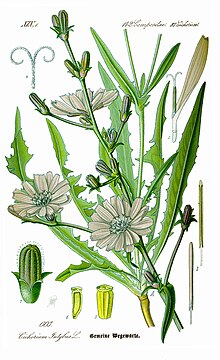
Chicory
Read More...Common chicory (Cichorium intybus) is a somewhat woody, perennial herbaceous plant of the family Asteraceae, usually with bright blue flowers, rarely white or pink. Native to the Old World, it has been introduced to the Americas and Australia.
Many varieties are cultivated for salad leaves, chicons (blanched buds), or roots (var. sativum), which are baked, ground, and used as a coffee substitute and food additive. In the 21st century, inulin, an extract from chicory root, has been used in food manufacturing as a sweetener and source of dietary fiber. Chicory is also grown as a forage crop for livestock.

Chorizo
Read More...Chorizo (, from Spanish [tʃoˈɾiθo]; Portuguese chouriço [ʃo(w)ˈɾisu]) is a type of pork sausage originating from the Iberian Peninsula. It is made in many national and regional varieties in several countries on different continents. Some of these varieties are quite different from each other, occasionally leading to confusion or disagreements over the names and identities of the products in question.
In Europe, Spanish chorizo and Portuguese chouriço is a fermented, cured, smoked sausage which gets its smokiness and deep red color from dried, smoked, red peppers (pimentón/colorau); it may be sliced and eaten without cooking, or added as an ingredient to add flavor to other dishes. Elsewhere, chorizo may not be fermented or cured, and require cooking before eating.
Iberian chorizo is eaten sliced in a sandwich, grilled, fried, or simmered in liquid, including apple cider or strong alcoholic beverages such as aguardiente. It is also used as a partial replacement for ground (minced) beef or pork.

Couscous
Read More...Couscous (Arabic: كُسْكُس, romanized: kuskus) is a traditional North African dish of small steamed granules of rolled semolina that is often served with a stew spooned on top. Pearl millet, sorghum, bulgur, and other cereals are sometimes cooked in a similar way in other regions, and the resulting dishes are also sometimes called couscous.: 18
Couscous is a staple food throughout the Maghrebi cuisines of Algeria, Tunisia, Mauritania, Morocco, and Libya.: 250 It was integrated into French and European cuisine at the beginning of the twentieth century, through the French colonial empire and the Pieds-Noirs of Algeria.
In 2020, couscous was added to UNESCO's Intangible Cultural Heritage list.
Crème fraîche
Read More...Crème fraîche (English pronunciation: , French pronunciation: [kʁɛm fʁɛʃ] , lit. "fresh cream") is a dairy product, a soured cream containing 10–45% butterfat, with a pH of approximately 4.5. It is soured with a bacterial culture. European labeling regulations specify the two ingredients must be cream and bacterial culture. It is served over fruit and baked goods, as well as being added to soups and sauces. It is used in a variety of other recipes. Sour cream is a similar foodstuff, except that crème fraîche is less sour and has a higher fat content. Sour cream may contain thickening agents not permitted in crème fraîche in many jurisdictions.
The name crème fraîche is French, but similar soured creams are found in much of northern Europe, and a traditional soured cream (crema fresca in Spanish) used in Central America resembles it.

Daikon
Read More...Daikon or mooli, Raphanus sativus var. longipinnatus, is a mild-flavored winter radish usually characterized by fast-growing leaves and a long, white, napiform root. Originally native to continental East Asia, daikon is harvested and consumed throughout the region, as well as in South Asia, and is available internationally. In some locations, daikon is planted for its ability to break up compacted soils and recover nutrients and is not harvested.

Edamame
Read More...Edamame (枝豆, ) is a Japanese dish prepared with immature soybeans in the pod. The pods are boiled or steamed and may be served with salt or other condiments. The dish has become popular across the world because it is rich in vitamins, dietary fiber, and isoflavones. When the beans are outside the pod, the term mukimame is also sometimes used in Japanese. Edamame are a common side dish in Japanese cuisine and as an appetizer to alcoholic beverages such as beer or shōchū. As an ingredient Edamame are found in both sweet and savory dishes such as takikomi gohan, tempura, and zunda-mochi.
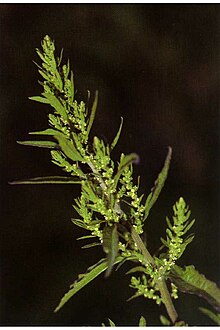
Epazote
Read More...Dysphania ambrosioides, formerly Chenopodium ambrosioides, known as Jesuit's tea, Mexican-tea, payqu (paico), epazote, mastruz, or herba sanctæ Mariæ, is an annual or short-lived perennial herb native to Central America, South America, and southern Mexico.
Escarole
Read More...Endive () is a leaf vegetable belonging to the genus Cichorium, which includes several similar bitter-leafed vegetables. Species include Cichorium endivia (also called endive), Cichorium pumilum (also called wild endive), and Cichorium intybus (also called chicory). Chicory includes types such as radicchio, puntarelle, and Belgian endive.
There is considerable confusion between Cichorium endivia and Cichorium intybus.
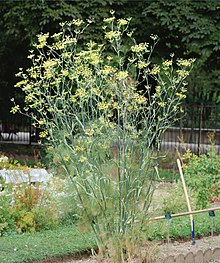
Fennel
Read More...Fennel (Foeniculum vulgare) is a flowering plant species in the carrot family. It is a hardy, perennial herb with yellow flowers and feathery leaves. It is indigenous to the shores of the Mediterranean but has become widely naturalized in many parts of the world, especially on dry soils near the sea coast and on riverbanks.
It is a highly flavorful herb used in cooking and, along with the similar-tasting anise, is one of the primary ingredients of absinthe. Florence fennel or finocchio (UK: , US: , Italian: [fiˈnɔkkjo]) is a selection with a swollen, bulb-like stem base that is used as a vegetable.
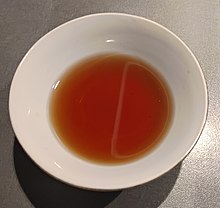
Fish sauce
Read More...Fish sauce is a liquid condiment made from fish or krill that have been coated in salt and fermented for up to two years.: 234 It is used as a staple seasoning in East Asian cuisine and Southeast Asian cuisine, particularly Myanmar, Cambodia, Laos, Philippines, Thailand, and Vietnam. Some garum-related fish sauces have been used in the West since the Roman times.
Due to its ability to add a savory umami flavor to dishes, it has been embraced globally by chefs and home cooks. The umami flavor in fish sauce is due to its glutamate content.
Fish sauce is used as a seasoning during or after cooking, and as a base in dipping sauces. Soy sauce is regarded by some in the West as a vegetarian alternative to fish sauce though they are very different in flavor.: 234

Ghee
Read More...Ghee is a type of clarified butter, originating from India. It is commonly used for cooking, as a traditional medicine, and for religious rituals.
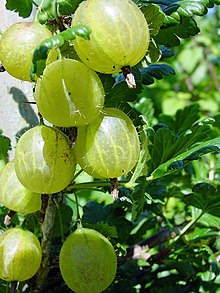
Gooseberry
Read More...Gooseberry ( GOOSS-berr-ee or GOOZ-berr-ee (American and northern British) or GUUZ-bər-ee (southern British)) is a common name for many species of Ribes (which also includes currants), as well as a large number of plants of similar appearance. The berries of those in the genus Ribes (sometimes placed in the genus Grossularia) are edible and may be green, orange, red, purple, yellow, white, or black.

Gravlax
Read More...Gravlax (Swedish: [ˈgrɑ̂ːvlakːs]) or graved salmon is a Nordic dish consisting of salmon that is cured using a mix of salt, sugar and dill. It is garnished with fresh dill or sprucetwigs and may occasionally be cold-smoked afterwards. Gravlax is usually served as an appetizer, sliced thinly and accompanied by hovmästarsås (literally 'maitre d'hôtel sauce', also known in Sweden as gravlaxsås, in Norway as sennepssaus, literally 'mustard sauce', in Denmark as rævesovs, literally 'fox sauce', in Iceland as graflaxsósa, and in Finland as hovimestarinkastike, literally 'butler sauce'), dill and mustard sauce, either on bread or with boiled potatoes.
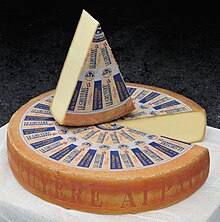
Gruyère cheese
Read More...Gruyère (UK: , US: , French: [ɡʁɥijɛʁ] ; German: Greyerzer) is a hard Swiss cheese that originated in the cantons of Fribourg, Vaud, Neuchâtel, Jura, and Berne in Switzerland. It is named after the town of Gruyères in Fribourg. In 2001, Gruyère gained the appellation d'origine contrôlée (AOC), which became the appellation d'origine protégée (AOP) as of 2013.
Gruyère is classified as a Swiss-type or Alpine cheese and is sweet but slightly salty, with a flavour that varies widely with age. It is often described as creamy and nutty when young, becoming more assertive, earthy, and complex as it matures. When fully aged (five months to a year), it tends to have small cracks that impart a slightly grainy texture. Unlike Emmental, with which it is often confused, modern Gruyère has few if any eyes, although in the 19th century, this was not always the case. The small cracks that can develop in Gruyère cheese are often referred to as "eyes." These eyes are round or irregularly shaped holes that are formed during the aging process. It is the most popular Swiss cheese in Switzerland, and in most of Europe.

Guanciale
Read More...Guanciale (Italian: [ɡwanˈtʃaːle]) is an Italian cured meat product prepared from pork jowl or cheeks. Its name is derived from guancia, the Italian word for 'cheek'.
Harissa
Read More...Harissa (Arabic: هريسة
harīsa , from Maghrebi Arabic) is a hot chili pepper paste, native to the Maghreb. The main ingredients are roasted red peppers, Baklouti peppers (بقلوطي), spices and herbs such as garlic paste, caraway seeds, coriander seeds, cumin and olive oil to carry the oil-soluble flavors. Rose harissa, made with rose petals, is also made.Tunisia is the biggest exporter of prepared harissa and UNESCO lists it as part of Tunisia's Intangible Cultural Heritage. The origin of harissa goes back to the importation of chili peppers into Maghrebian cuisine by the Columbian exchange, presumably during the Spanish occupation of Ottoman Tunisia between 1535 and 1574.
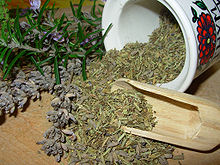
Herbes de Provence
Read More...Herbes de Provence (French: [ɛʁb də pʁɔvɑ̃s]; Provençal: èrbas de Provença) is a mixture of dried herbs considered typical of the Provence region of southeastern France. Formerly simply a descriptive term, commercial blends started to be sold under this name in the 1970s. These blends often contain savory, marjoram, rosemary, thyme, and oregano. Lavender leaves are also sometimes included, especially in North American formulations. The herb mixture is typically used with grilled foods and stews.

Jaggery
Read More...Jaggery is a traditional non-centrifugal cane sugar consumed in the Indian subcontinent, Southeast Asia, Central America, Pakistan, Brazil and Africa. It is a concentrated product of cane juice and often date or palm sap without separation of the molasses and crystals, and can vary from golden brown to dark brown in colour. It contains up to 50% sucrose, up to 20% invert sugars, and up to 20% moisture, with the remainder made up of other insoluble matter, such as wood ash, proteins, and bagasse fibres. Jaggery is very similar to muscovado, an important sweetener in Portuguese, British and French cuisine. The Kenyan Sukari ngutu/nguru has no fibre; it is dark and is made from sugarcane and also sometimes extracted from palm tree.

Jicama
Read More...Pachyrhizus erosus, commonly known as jícama ( or ; Spanish jícama [ˈxikama] ; from Nahuatl xīcamatl, [ʃiːˈkamatɬ]) or Mexican turnip, is a native Mexican vine, although the name jícama most commonly refers to the plant's edible tuberous root. It is in the pea family (Fabaceae). Pachyrhizus tuberosus and Pachyrhizus ahipa are the other two cultivated species in the genus. The naming of this group of edible plants can sometimes be confusing, with much overlap of similar or the same common names.
Flowers, either blue or white, and pods similar to peas, are produced on fully developed plants. Several species of Pachyrhizus are known as jícama, but the one found in many markets is P. erosus. The two cultivated forms of P. erosus are jícama de agua and jícama de leche, both named for the consistency of their juice. The leche form has an elongated root and milky juice, while the agua form has a top-shaped to oblate root and a more watery, translucent juice and is the preferred form for the market.

Kohlrabi
Read More...Kohlrabi (German: [koːlˈʁaːbi] ; pronounced in English; scientific name Brassica oleracea Gongylodes Group), also called German turnip or turnip cabbage, is a biennial vegetable, a low, stout cultivar of wild cabbage. It is a cultivar of the same species as cabbage, broccoli, cauliflower, kale, Brussels sprouts, collard greens, Savoy cabbage, and gai lan.
It can be eaten raw or cooked. Edible preparations are made with both the stem and the leaves. Despite its common names, it is not the same species as turnip, although both are in the genus Brassica.

Leek
Read More...The leek is a vegetable, a cultivar of Allium ampeloprasum, the broadleaf wild leek (syn. Allium porrum). The edible part of the plant is a bundle of leaf sheaths that is sometimes erroneously called a stem or stalk. The genus Allium also contains the onion, garlic, shallot, scallion, chives, and Chinese onion. Three closely related vegetables, elephant garlic, kurrat and Persian leek or tareh, are also cultivars of A. ampeloprasum, although different in their uses as food.
Lemongrass
Read More...Cymbopogon, also known as lemongrass, barbed wire grass, silky heads, oily heads, Cochin grass, Malabar grass, citronella grass or fever grass, is a genus of Asian, African, Australian, and tropical island plants in the grass family. Some species (particularly Cymbopogon citratus) are commonly cultivated as culinary and medicinal herbs because of their scent, resembling that of lemons (Citrus limon). The name cymbopogon derives from the Greek words kymbe (κύμβη, 'boat') and pogon (πώγων, 'beard') "which mean [that] in most species, the hairy spikelets project from boat-shaped spathes." Lemongrass and its oil are believed to possess therapeutic properties.

Lingonberry
Read More...Vaccinium vitis-idaea, the lingonberry, partridgeberry, mountain cranberry or cowberry, is a small evergreen shrub in the heath family Ericaceae, that bears edible fruit. It is native to boreal forest and Arctic tundra throughout the Northern Hemisphere, from Europe and Asia to North America. Lingonberries are picked in the wild and used to accompany various dishes, primarily in the Nordic countries. Commercial cultivation is undertaken in the U.S. Pacific Northwest and in the Netherlands.
Lychee
Read More...Lychee (US: LEE-chee, UK: LIE-chee; Litchi chinensis; Chinese: 荔枝; pinyin: lìzhī; Jyutping: lai6 zi1; Pe̍h-ōe-jī: nāi-chi) is a monotypic taxon and the sole member in the genus Litchi in the soapberry family, Sapindaceae.
It is a tropical tree native to South China, Malaysia, and northern Vietnam. The tree has been introduced throughout Southeast Asia and South Asia. Cultivation in China is documented from the 11th century. China is the main producer of lychees, followed by Vietnam, India, other countries in Southeast Asia, other countries in the Indian subcontinent, Madagascar, and South Africa. A tall evergreen tree, it bears small fleshy sweet fruits. The outside of the fruit is a pink-red, rough-textured soft shell.
Lychee seeds contain methylene cyclopropyl glycine which has caused hypoglycemia associated with outbreaks of encephalopathy in undernourished Indian and Vietnamese children who consumed lychee fruit.
Marjoram
Read More...Marjoram (; Origanum majorana) is a cold-sensitive perennial herb or undershrub with sweet pine and citrus flavours. In some Middle Eastern countries, marjoram is synonymous with oregano, and there the names sweet marjoram and knotted marjoram are used to distinguish it from other plants of the genus Origanum. It is also called pot marjoram, although this name is also used for other cultivated species of Origanum.

Mascarpone
Read More...Mascarpone (, US also , Italian: [maskarˈpoːne]) is a soft Italian acid-set cream cheese. It is recognized in Italy as a prodotto agroalimentare tradizionale ("traditional agri-food product"; PAT).

Miso
Read More...Miso (みそ or 味噌) is a traditional Japanese seasoning. It is a thick paste produced by fermenting soybeans with salt and kōji (the fungus Aspergillus oryzae) and sometimes rice, barley, seaweed, or other ingredients. It is used for sauces and spreads, pickling vegetables, fish, or meats, and mixing with dashi soup stock to serve as miso soup, a Japanese culinary staple. Miso is high in protein and rich in vitamins and minerals, and it played an important nutritional role in feudal Japan. Miso is still widely used in both traditional and modern cooking in Japan and has been gaining worldwide interest.
Typically, miso is salty, but its flavor and aroma depend on the ingredients and fermentation process. Different varieties of miso have been described as salty, sweet, earthy, fruity, and savory.

Morel
Read More...Morchella, the true morels, is a genus of edible sac fungi closely related to anatomically simpler cup fungi in the order Pezizales (division Ascomycota). These distinctive fungi have a honeycomb appearance due to the network of ridges with pits composing their caps. Morels are prized by gourmet cooks, particularly in Catalan and French cuisine. Due to difficulties in cultivation, commercial harvesting of wild morels has become a multimillion-dollar industry in the temperate Northern Hemisphere, in particular North America, Turkey, China, the Himalayas, India, and Pakistan where these highly prized fungi are found in abundance.
Typified by Morchella esculenta in 1794, the genus has been the source of considerable taxonomical controversy throughout the years, mostly with regard to the number of species involved, with some mycologists recognising as few as three species and others over thirty. Current molecular phylogenetics suggest there might be over seventy species of Morchella worldwide, most of them exhibiting high continental endemism and provincialism.
The genus is currently the focus of extensive phylogenetic, biogeographical, taxonomical and nomenclatural studies, and several new species have been described from Australia, Canada, Cyprus, Israel, Spain, and Turkey.
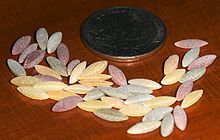
Orzo
Read More...Orzo (lit. 'barley'; ; Italian: [ˈɔrdzo]; from Latin hordeum), also known as risoni (pronounced [riˈzoːni]; 'large [grains of] rice'), is a form of short-cut pasta, shaped like a large grain of rice. Orzo is traditionally made from flour, but it can also be made of whole grain. It is often made with semolina, a type of flour made from durum wheat.
Orzo, oftеn mistakеn for ricе duе to its small, ricе-likе shapе, possеssеs a uniquе ability to adapt and еnhancе various dishеs.
The name orzo is common for this pasta shape in North America, but less so in Italy, where the word usually still means 'barley'.

Paneer
Read More...Paneer (pronounced [/pəˈniːr/]), also known as panir (pronounced [pani̯r]), is a fresh acid-set cheese common in the cuisine of the Indian subcontinent made from full-fat buffalo milk or cow milk. It is a non-aged, non-melting soft cheese made by curdling milk with a fruit- or vegetable-derived acid, such as lemon juice.
Piloncillo
Read More...Panela (Spanish pronunciation: [paˈnela]) or rapadura (Portuguese pronunciation: [ʁapaˈduɾɐ]) is an unrefined whole cane sugar, typical of Latin America. It is a solid form of sucrose derived from the boiling and evaporation of sugarcane juice. Panela is known by other names in Latin America, such as chancaca in Chile, Bolivia, and Peru, piloncillo in Mexico (where panela refers to a type of cheese, queso panela). Just like brown sugar, two varieties of piloncillo are available; one is lighter (blanco) and one darker (oscuro). Unrefined, it is commonly used in Mexico, where it has been around for at least 500 years. Made from crushed sugar cane, the juice is collected, boiled, and poured into molds, where it hardens into blocks. It is similar to jaggery, which is used in South Asia. Both are considered non-centrifugal cane sugars.
Panela is sold in many forms, including liquid, granulated, and solid blocks, and is used in the canning of foods, as well as in confectionery, soft drinks, baking, and vinegar, beer, and winemaking.

Plantain
Read More...Cooking bananas are banana cultivars in the genus Musa whose fruits are generally used in cooking. They may be eaten ripe or unripe and are generally starchy. Many cooking bananas are referred to as plantains (/ˈplæntɪn/, /plænˈteɪn/, /ˈplɑːntɪn/) or 'green bananas'. In botanical usage, the term "plantain" is used only for true plantains, while other starchy cultivars used for cooking are called "cooking bananas". True plantains are cooking cultivars belonging to the AAB group, while cooking bananas are any cooking cultivar belonging to the AAB, AAA, ABB, or BBB groups. The currently accepted scientific name for all such cultivars in these groups is Musa × paradisiaca. Fe'i bananas (Musa × troglodytarum) from the Pacific Islands are often eaten roasted or boiled, and are thus informally referred to as "mountain plantains", but they do not belong to any of the species from which all modern banana cultivars are descended.
Cooking bananas are a major food staple in West and Central Africa, the Caribbean islands, Central America, and northern South America. Members of the genus Musa are indigenous to the tropical regions of Southeast Asia and Oceania. Bananas fruit all year round, making them a reliable all-season staple food.
Cooking bananas are treated as a starchy fruit with a relatively neutral flavor and soft texture when cooked. Cooking bananas may be eaten raw; however, they are most commonly prepared either fried, boiled, or processed into flour or dough.

Poblano
Read More...The poblano (Capsicum annuum) is a mild chili pepper originating in the state of Puebla, Mexico. Dried, it is called ancho or chile ancho, from the Spanish word ancho ("wide"). Stuffed fresh and roasted it is popular in chiles rellenos poblanos.
While poblanos tend to have a mild flavor, occasionally and unpredictably they can have significant heat. Different peppers from the same plant have been reported to vary substantially in heat intensity. The ripened red poblano is significantly hotter and more flavorful than the less ripe, green poblano.
A closely related variety is the mulato, which is darker in color, sweeter in flavor, and softer in texture. The pasilla pepper is sometimes incorrectly called "poblano", particularly in the United States, but they are distinct from true poblano peppers.

Pomegranate
Read More...The pomegranate (Punica granatum) is a fruit-bearing deciduous shrub in the family Lythraceae, subfamily Punicoideae, that grows between 5 and 10 m (16 and 33 ft) tall. The pomegranate is rich in symbolic and mythological associations in many cultures.
The pomegranate was thought to have originated from Afghanistan and Iran before being introduced and exported to other parts of Asia, Africa, and Europe. It was introduced into Spanish America in the late 16th century and into California by Spanish settlers in 1769. They are widely cultivated throughout West Asia and Caucasus region, South Asia, Central Asia, north and tropical Africa, the drier parts of Southeast Asia, and the Mediterranean Basin. The fruit is typically in season in the Southern Hemisphere from March to May, and in the Northern Hemisphere from September to February.
As intact sarcotestas or as juice, pomegranates are used in baking, cooking, juice blends, meal garnishes, smoothies, and alcoholic beverages, such as cocktails and wine.

Pomelo
Read More...The pomelo ( POM-il-oh, PUM-; Citrus maxima), from the family Rutaceae, is the largest citrus fruit, and the principal ancestor of the grapefruit. It is a natural, non-hybrid, citrus fruit, native to Southeast Asia. Similar in taste to a sweet grapefruit, the pomelo is commonly consumed and used for festive occasions throughout Southeast Asia and East Asia. As with the grapefruit, phytochemicals in the pomelo have the potential for drug interactions.

Prosciutto
Read More...Prosciutto crudo, in English often shortened to prosciutto ( prə-SHOO-toh, proh-, Italian: [proʃˈʃutto]), is uncooked, unsmoked, and dry-cured ham. Prosciutto crudo is usually served thinly sliced.
Several regions in Italy have their own variations of prosciutto crudo, each with degrees of protected status, but the most prized are prosciutto di Parma DOP, from Emilia-Romagna, and prosciutto di San Daniele DOP, from Friuli Venezia Giulia. Unlike speck (Speck Alto Adige PGI) from the South Tyrol region, prosciutto is not smoked. There is also a tradition of making prosciutto in southern Switzerland.
In Italian, prosciutto means any kind of ham, either dry-cured (prosciutto crudo or simply crudo) or cooked (prosciutto cotto), but in English-speaking countries, it usually means either Italian prosciutto crudo or similar hams made elsewhere. However, the word "prosciutto" itself is not protected; cooked ham may legally be, and in practice is, sold as prosciutto (usually as prosciutto cotto, and from Italy or made in the Italian style) in English-speaking regions.

Quinoa
Read More...Quinoa (Chenopodium quinoa; , from Quechua kinwa or kinuwa) is a flowering plant in the amaranth family. It is an herbaceous annual plant grown as a crop primarily for its edible seeds; the seeds are rich in protein, dietary fiber, B vitamins and dietary minerals in amounts greater than in many grains. Quinoa is not a grass but rather a pseudocereal botanically related to spinach and amaranth (Amaranthus spp.), and originated in the Andean region of northwestern South America. It was first used to feed livestock 5,200–7,000 years ago, and for human consumption 3,000–4,000 years ago in the Lake Titicaca basin of Peru and Bolivia.
The plant thrives at high elevations and produces seeds that are rich in protein. Almost all production in the Andean region is done by small farms and associations. Its cultivation has spread to more than 70 countries, including Kenya, India, the United States and European countries. As a result of increased popularity and consumption in North America, Europe, and Australasia, quinoa crop prices tripled between 2006 and 2014.

Raclette
Read More...Raclette (, French: [ʁaklɛt] ) is a French dish, also popular in the other Alpine countries, based on heating cheese and scraping off the melted part, then typically served with boiled potatoes. Raclette cheese is historically a dish originating from the canton of Valais in Switzerland. This cheese from Valais benefits from an AOP. Raclette cheese is also a Swiss-type cheese marketed specifically to be used for this dish.
Raclette is also served as street food, but often with bread instead of potatoes.

Radicchio
Read More...Radicchio ( rə-DIK-ee-oh or rə-DEE-kee-oh, Italian: [raˈdikkjo]), sometimes known as Italian chicory because of its common use in Italian cuisine, is a perennial cultivated form of leaf chicory (Cichorium intybus, Asteraceae). It is grown as a leaf vegetable and usually has colorful, white-veined red leaves that form a head. Radicchio has a bitter and spicy taste that mellows if it is grilled or roasted.

Ricotta
Read More...Ricotta (Italian pronunciation: [riˈkɔtta]) is an Italian whey cheese made from sheep, cow, goat, or Italian water buffalo milk whey left over from the production of other cheeses. Like other whey cheeses, it is made by coagulating the proteins that remain after the casein has been used to make cheese, notably albumin and globulin.
Ricotta (literally meaning "recooked", "refined") protein can be harvested if the whey is first allowed to become more acidic by additional fermentation (by letting it sit for 12–24 hours at room temperature). Then the acidified whey is heated to near boiling. The combination of low pH and high temperature denatures the protein and causes it to flocculate, forming a fine curd. Once cooled, it is separated by passing the liquid through a fine cloth, leaving the curd behind.
Ricotta curds are creamy white in appearance, and slightly sweet in taste. The fat content varies depending on the milk used. In this form, it is somewhat similar in texture to some fresh cheese variants, though considerably lighter. It is highly perishable. However, ricotta is also made in aged varieties which are preservable for much longer.

Saffron
Read More...Saffron () is a spice derived from the flower of Crocus sativus, commonly known as the "saffron crocus". The vivid crimson stigma and styles, called threads, are collected and dried for use mainly as a seasoning and colouring agent in food. Although some doubts remain on its origin, it is believed that saffron originated in Iran. However, Greece and Mesopotamia have also been suggested as the possible region of origin of this plant. The saffron crocus was slowly propagated throughout much of Eurasia and was later brought to parts of North Africa, North America, and Oceania.
Saffron's taste and iodoform-like or hay-like fragrance result from the phytochemicals picrocrocin and safranal. It also contains a carotenoid pigment, crocin, which imparts a rich golden-yellow hue to dishes and textiles. Its recorded history is attested in a 7th-century BC Assyrian botanical treatise, and it has been traded and used for thousands of years. As of 2018, Iran produced some 88% of the world total for saffron. At US$5,000 per kg or higher, saffron has long been the world's costliest spice by weight.

Salsify
Read More...Pseudopodospermum hispanicum, commonly known as black salsify or Spanish salsify, also known as black oyster plant, serpent root, viper's herb, viper's grass or simply scorzonera, is a perennial species of plant in the sunflower family (Asteraceae), cultivated as a root vegetable in the same way as purple salsify (Tragopogon porrifolius), also in the sunflower family. It is native to Southern Europe and cultivated as a crop in Southern and Central Europe. It grows on nutrient poor soils, dry pasture, rocky areas, in thickets and on limy or marly soils of temperate zones.

Soba
Read More...Soba (そば or 蕎麦, "buckwheat") are thin Japanese noodles made from buckwheat. The noodles are served either chilled with a dipping sauce, or hot in a noodle soup. The variety Nagano soba includes wheat flour.
In Japan, soba noodles can be found in a variety of settings, from "fast food" venues to expensive specialty restaurants. Markets sell dried noodles and men-tsuyu, or instant noodle broth, to make home preparation easy. A wide variety of dishes, both hot for winter and cold for summer, uses these noodles.
The amino acid balance of the protein in buckwheat, and therefore in soba, is well matched to the needs of humans and can complement the amino acid deficiencies of other staples such as rice and wheat (see protein combining). The tradition of eating soba arose in the Edo period.

Soy sauce
Read More...Soy sauce (sometimes called soya sauce in British English) is a liquid condiment of Chinese origin, traditionally made from a fermented paste of soybeans, roasted grain, brine, and Aspergillus oryzae or Aspergillus sojae molds. It is recognized for its pronounced umami taste.
Soy sauce was created in its current form about 2,200 years ago during the Western Han dynasty of ancient China. Since then, it has become an important ingredient in East and Southeast Asian cooking as well as a condiment worldwide.

Speck
Read More...Speck can refer to a number of European cured pork products, typically salted and air-cured and often lightly smoked but not cooked. In Germany, speck is pickled pork fat with or without some meat in it. Throughout much of the rest of Europe and parts of the English-speaking culinary world, speck often refers to South Tyrolean speck, a type of Italian smoked ham. The term "speck" became part of popular parlance only in the eighteenth century and replaced the older term "bachen", a cognate of "bacon".

Squab
Read More...In culinary terminology, squab is an immature domestic pigeon, typically under four weeks old, or its meat. Some authors describe it as tasting like dark chicken.
The word "squab" probably comes from Scandinavia; the Swedish word skvabb means "loose, fat flesh". The term formerly applied to all dove and pigeon species (such as the wood pigeon, the mourning dove, the extinct-in-the-wild socorro dove, and the now extinct passenger pigeon,) and their meat. More recently, squab meat comes almost entirely from domesticated pigeons. The meat of dove and pigeon gamebirds hunted primarily for sport is rarely called "squab".
The practice of domesticating pigeons as livestock may have originated in North Africa; historically, many societies have consumed squabs or pigeons, including ancient Egypt (still common in modern Egypt), Rome, China, India (Northeast), and medieval Europe. Although squab has been consumed throughout much of recorded history, it is generally regarded as exotic, not as a contemporary staple food; there are more records of its preparation for the wealthy than for the poor.
The modern squab industry uses utility pigeons. Squab farmers raise the young until they are roughly a month old (when they reach adult size but have not yet flown) before slaughter.

Stilton cheese
Read More...Stilton is an English cheese, produced in two varieties: Blue, which has Penicillium roqueforti added to generate a characteristic smell and taste, and White, which does not. Both have been granted the status of a protected designation of origin (PDO) by the European Commission, requiring that only such cheese produced in the three counties of Derbyshire, Leicestershire and Nottinghamshire may be called Stilton. The cheese takes its name from the village of Stilton, now in Cambridgeshire, where it has long been sold, but cannot be made because it is not in one of the three permitted counties.
Tahini
Read More...Tahini () or tahina (Arabic: طحينة, ) is an Arab condiment made from toasted ground hulled sesame. It is served by itself (as a dip) or as a major ingredient in hummus, baba ghanoush, and halva.
Tahini is used in the cuisines of the Levant and Eastern Mediterranean, the South Caucasus, the Balkans, South Asia, Central Asia, and amongst Ashkenazi Jews as well as parts of Russia and North Africa. Sesame paste (though not called tahini) is also used in some East Asian cuisines.
Tamarind
Read More...Tamarind (Tamarindus indica) is a leguminous tree bearing edible fruit that is indigenous to tropical Africa and naturalized in Asia. The genus Tamarindus is monotypic, meaning that it contains only this species. It belongs to the family Fabaceae.
The tamarind tree produces brown, pod-like fruits that contain a sweet, tangy pulp, which is used in cuisines around the world. The pulp is also used in traditional medicine and as a metal polish. The tree's wood can be used for woodworking and tamarind seed oil can be extracted from the seeds. Tamarind's tender young leaves are used in South Indian and Filipino cuisine. Because tamarind has multiple uses, it is cultivated around the world in tropical and subtropical zones.

Tarragon
Read More...Tarragon (Artemisia dracunculus), also known as estragon, is a species of perennial herb in the family Asteraceae. It is widespread in the wild across much of Eurasia and North America and is cultivated for culinary and medicinal purposes.
One subspecies, Artemisia dracunculus var. sativa, is cultivated to use the leaves as an aromatic culinary herb. In some other subspecies, the characteristic aroma is largely absent. Informal names for distinguishing the variations include "French tarragon" (best for culinary use), "Russian tarragon," and "wild tarragon" (covers various states).
Tarragon grows to 120–150 centimetres (4–5 feet) tall, with slender branches. The leaves are lanceolate, 2–8 cm (1–3 in) long and 2–10 mm (1⁄8–3⁄8 in) broad, glossy green, with an entire margin. The flowers are produced in small capitula 2–4 mm (1⁄16–3⁄16 in) diameter, each capitulum containing up to 40 yellow or greenish-yellow florets. French tarragon, however, seldom produces any flowers (or seeds). Some tarragon plants produce seeds that are generally sterile. Others produce viable seeds. Tarragon has rhizomatous roots that it uses to spread and readily reproduce.

Tempeh
Read More...Tempeh or tempe (; Javanese: ꦠꦺꦩ꧀ꦥꦺ, romanized: témpé, Javanese pronunciation: [tempe]) is a traditional Indonesian food made from fermented soybeans. It is made by a natural culturing and controlled fermentation process that binds soybeans into a cake form. A fungus, Rhizopus oligosporus or Rhizopus oryzae, is used in the fermentation process and is also known as tempeh starter.
It is especially popular on the island of Java, where it is a staple source of protein. Like tofu, tempeh is made from soybeans, but it is a whole-soybean product with different nutritional characteristics and textural qualities. Tempeh's fermentation process and its retention of the whole bean give it a higher content of protein, dietary fiber, and vitamins. It has a firm texture and an earthy flavor, which becomes more pronounced as it ages.
Tofu
Read More...Tofu (Japanese: 豆腐, Hepburn: Tōfu, Korean: 두부 Chinese: 豆腐; pinyin: dòufu) is a food prepared by coagulating soy milk and then pressing the resulting curds into solid white blocks of varying softness: silken, soft, firm, extra (or super) firm. Tofu is also known as bean curd in English. It is a traditional component of East Asian and Southeast Asian cuisines, and has been consumed in China for over 2,000 years. In modern Western cooking, it is most often treated as a meat substitute.
Nutritionally, tofu is low in calories, while containing a relatively large amount of protein. It is high in iron, and can have a high calcium or magnesium content depending on the coagulants (e.g. calcium chloride, calcium sulphate, magnesium sulphate) used in manufacturing.

Tomatillo
Read More...The tomatillo (Physalis philadelphica and Physalis ixocarpa), also known as the Mexican husk tomato, is a plant of the nightshade family bearing small, spherical, and green or green-purple fruit of the same name. Tomatillos originated in Mexico and were cultivated in the pre-Columbian era. A staple of Mexican cuisine, they are eaten raw and cooked in a variety of dishes, particularly salsa verde. The tomatillo is a perennial plant but is generally grown for agriculture each year as if it were an annual.
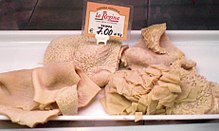
Tripe
Read More...Tripe is a type of edible lining from the stomachs of various farm animals. Most tripe is from cattle, pigs and sheep.

Turmeric
Read More...Turmeric () or Curcuma longa (), is a flowering plant in the ginger family Zingiberaceae. It is a perennial, rhizomatous, herbaceous plant native to the Indian subcontinent and Southeast Asia that requires temperatures between 20 and 30 °C (68 and 86 °F) and high annual rainfall to thrive. Plants are gathered each year for their rhizomes, some for propagation in the following season and some for consumption.
The rhizomes are used fresh or boiled in water and dried, after which they are ground into a deep orange-yellow powder commonly used as a coloring and flavoring agent in many Asian cuisines, especially for curries, as well as for the dyeing characteristics imparted by the principal turmeric constituent, curcumin.
Turmeric powder has a warm, bitter, black pepper-like flavor and earthy, mustard-like aroma.
Curcumin, a bright yellow chemical produced by the turmeric plant, is approved as a food additive by the World Health Organization, European Parliament, and United States Food and Drug Administration.
Although long used in Ayurvedic medicine, where it is also known as haridra, there is no high-quality clinical evidence that consuming turmeric or curcumin is effective for treating any disease.
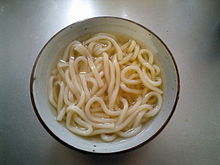
Udon
Read More...Udon (うどん or 饂飩) is a thick noodle made from wheat flour, used in Japanese cuisine. There is a variety of ways it is prepared and served. Its simplest form is in a soup as kake udon with a mild broth called kakejiru made from dashi, soy sauce, and mirin. It is usually topped with thinly chopped scallions. Other common toppings include prawn tempura, kakiage (mixed tempura fritter), abura-age (sweet, deep-fried tofu pouches), kamaboko (sliced fish cake), and shichimi spice added to taste.
Standard broth differs by region. Dark (koikuchi) soy sauce is added in eastern Japan, while light (usukuchi) soy sauce is added in the west. Instant noodles are often sold in two (or more) versions accordingly.
More unusual variants include stir-fried yaki udon and curry udon made with Japanese curry. It is often used in shabu shabu or Japanese hot pot.

Uni
Read More...The gonads of both male and female sea urchins, sometimes euphemized as sea urchin "roe" or "corals",[69] are culinary delicacies in many parts of the world, especially Japan.[70][71][72] In Japan, sea urchin is known as uni (うに), and its gonads (the only meaty, edible parts of the animal) can retail for as much as ¥40,000 ($360) per kilogram;[73] they are served raw as sashimi or in sushi, with soy sauce and wasabi. Japan imports large quantities from the United States, South Korea, and other producers. Japan consumes 50,000 tons annually, amounting to over 80% of global production.[74] Japanese demand for sea urchins has raised concerns about overfishing.[75]

Vegemite
Read More...Vegemite ( VEJ-ee-myte) is a thick, dark brown Australian food spread made from leftover brewers' yeast extract with various vegetable and spice additives. It was developed by Cyril Callister in Melbourne, Victoria, in 1922, and it was first sold in stores on 25 October 1923.
A spread for sandwiches, toast, crumpets and cracker biscuits as well as a filling for pastries, Vegemite is similar to British Marmite, New Zealand Marmite, Australian Promite, MightyMite, AussieMite, OzEmite, German Vitam-R, and Swiss Cenovis.
Vegemite has a strong flavour. It is salty, slightly bitter, malty, and has an umami flavour similar to beef bouillon (because it is rich in glutamates). It is low FODMAP, vegan, kosher, and halal. It is known for being high in B vitamins.
The Vegemite brand returned to Australian ownership in 2017 when the Bega Group purchased it alongside other assets from Mondelez International (formerly Kraft Foods Inc.).
Vermicelli
Read More...Vermicelli (Italian: [vermiˈtʃɛlli]; lit. 'little worms'; , also UK: ) is a traditional type of pasta round in section similar to spaghetti. In English-speaking regions, it is usually thinner than spaghetti, while in Italy, it is thicker.

Yuzu
Read More...Yuzu (Citrus × junos, from Japanese 柚子 or ユズ; ) is a citrus fruit and plant in the family Rutaceae of East Asian origin. Yuzu has been cultivated mainly in East Asia, though recently also in New Zealand, Australia, Spain, Italy, and France.
It is believed to have originated in central China as an F1 hybrid of the mangshanyeju subspecies of mandarin orange and the ichang papeda.










